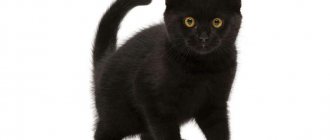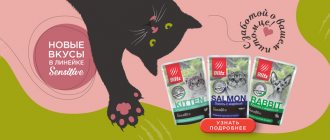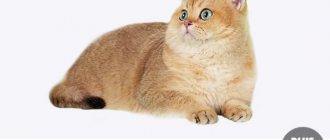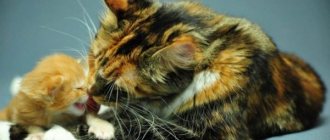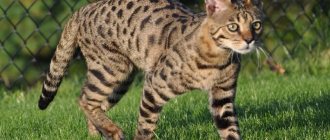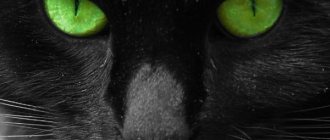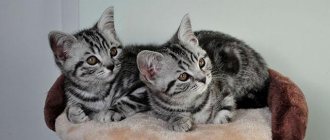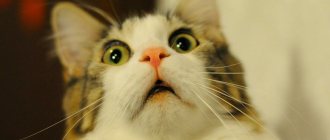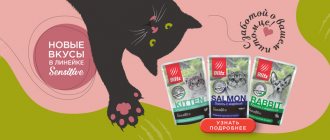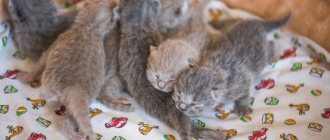Nature has endowed all cats with a difficult character, but black cats are also distinguished by their unusual appearance. People blame these animals for all misfortunes and superstitiously try not to cross them on the road.
Apparently, this is how the subconscious fear of the dizzying beauty of animals in shiny coal-colored coats is expressed. But this color in different combinations is found in almost all cat breeds.
Genetics of black color
The pigment pheomelanin is responsible for the red color, and eumelanin is responsible for the black color. In cat hair they are presented in the form of granules, the shape, quantity and location of which determine the color shade. Let’s leave the first one (red) aside, and consider the second one in detail.
- In black cat breeds, the B (black) gene is responsible for color. In the genotype of an animal, it can be represented in three alleles (species): dominant B, recessive b and bl.
- In the dominant state, the gene forms almost round (slightly elongated at the poles) eumelanin granules with a dense arrangement in the hairs. This gives a rich black color.
- The recessive allele b of the same gene stretches the pigment granules and moves them away from each other. It turns out to be a chocolate shade.
- The final form of bl is even more expanded eumelanin capsules and a sparse arrangement. On the hair this gives the color of cinnamon (cinnamon), characteristic of many breeds.
All other characteristics do not play a role in the color of interest - a large black cat is necessarily a carrier of the dominant B gene.
This is interesting! In black cats, there is no relationship between coat color and the sex of the animal. Their genes are not connected to the chromosomes that are responsible for dividing into “boys” and “girls.”
Video on the topic
Yard cats are ordinary mongrel cats that do not have owners and live mostly in the basements of city multi-storey buildings. They have to defend their small territory and constantly obtain the food they need to survive. The life expectancy of yard cats is 3-5 times less than that of domestic cats. On average they live about 5 years. And not everyone reaches this age; many die while still kittens. There is no one to take care of them, but they are the same living creatures as ordinary domestic cats. They look into your eyes and seem to ask: “Why does the world work this way? Why are there abandoned and homeless people?” Some people get affection, love and a prosperous life, while the homeless have to constantly fight for their survival. This is the other side of the so-called freedom, which the vast majority of yard cats do not need at all. They would gladly exchange it for a well-fed and carefree home life.
In general, all modern cat breeds are descended from their wild ancestor – the forest cat. Its appearance still exists today. This is a small predator that hunts rodents, birds and small mammals. The name itself speaks of its habitat – forest. By nature, the forest cat is timid and aggressive. He tries not to get close to the person and his home. Man began to tame and domesticate cats more than ten thousand years ago. On the island of Crete in 2004, a burial was found, subsidized by the 9th-7th millennium BC (before the 1st year according to the Julian and Gregorian calendars, before the birth of Christ). By the way, BC are calculated in reverse order, that is, in the decreasing direction. Next to the human burial, archaeologists also found the skeleton of a kitten. Since cats did not live on the island at that time, it means that it was brought there from other places. Only a person could do this. Considering this information, we can say that the kitten in those distant millennia was already domesticated to some extent (lived with humans).
At the very beginning, a person's interest in a cat was purely practical. People were engaged in agriculture. The results of their labor from this type of activity were stored in various rooms, a kind of storage. They were greatly annoyed by rodents. They simply destroyed part of the crop. Then the man noticed the cat, which is a very good rodent hunter. This was the main reason that prompted man to domesticate the cat. Subsequently, for the wealthy class, the cat's hunting abilities were not so important. They began to use cats as decorative pets.
One of the most developed ancient civilizations was Egyptian. It is no wonder that the greatest amount of information that has reached us about the life of cats in that distant time comes from Egypt. Here the cat was even identified with the goddess of joy, love, fun, female beauty and fertility, who bore the name Bastet (Bast). She was depicted as a woman with the head of a cat. In Ancient Egypt, Bastet was revered as a national deity, and cats were almost sacred animals. If someone's cat died, the owners shaved off their eyebrows as a sign of mourning for her, which lasted 70 days. Children were forbidden to chase or hit them with a stick. Even if some careless driver accidentally runs over a cat with a cart, he could be stoned. The center of the cult of the goddess Bastet was the city of Bubastis, located in the southeast of the Nile River delta. The city ceased to exist in the middle of the first millennium AD. In honor of the goddess Bastet, one of the most beautiful temples of Ancient Egypt was built in the city and there was a necropolis of mummified cats. The ancient Greek historian Herodotus (484 - 425 BC, the father of history) wrote: “... The corpses of cats are taken to the city of Bubastis, embalmed and buried there in sacred chambers...”.
Characteristic eye color
The genetics of the pupil is less studied than the properties of fur. Researchers suggest the presence of a color gene and some polygenes that are located outside the studied structures and affect the characteristic features of the organism.
Felinologists identify three most common combinations:
- Black cats with green (grn) eyes are a classic color combination.
- The second group is orange, brown and amber-honey (org) eyes.
- The final position is in the copper color range (cpr). Fairytale black cats with red eyes actually come from this category.
When recessive alleles (b, bl) come into play and various shades appear on the cat's coat, the pupil color combinations automatically dilate. But absolutely black cats have only the three listed eye colors.
This is interesting! Black coat color is never ideal. It all depends only on the degree of its saturation, which hides some natural pigmentation flaws.
Strengths of mongrels
Each purebred cat is unique and valued for some of its exceptional characteristics. Yard mustaches may in some ways not be comparable to their purebred counterparts, but they have a lot of advantages:
- Health. The life expectancy of mongrels is usually longer than that of purebred purrs, because the former have a stronger and more lasting immunity to most street infections. Selection work weakens the protective functions of the cat’s body.
- Temperament. Domestic breeds have the most flexible and gentle character. If such a cat is picked up on the street, then its joy will know no bounds - it will become attached to its owner for life.
- Knitting. Finding a partner for a yard pet will not be difficult. Most likely you will have many options to choose from. Waiting for a new offspring is always a mystery, because it is impossible to predict what coat color, color and eye shape the future kittens will have. It is quite possible that such a kitten will become the founder of a new breed.
- Help with housekeeping. Catching an annoying rodent will not be difficult for a mongrel; they have a well-developed natural instinct.
- Exhibitions. There are exhibitions for outbred pets, where the external characteristics of purrs and their grooming are assessed. It’s great that yard breeds also have the opportunity to show themselves in all their glory.
- Price. Anyone can buy a yard pet. Usually they come to visit themselves, offering to leave themselves. In this case, it is almost impossible to refuse.
Bombay cat: black standard breed
Bombays are short-haired black cats, fit, graceful, with shiny golden-copper eyes. Their coat has a glossy satin texture, it is evenly colored along the entire length of the hair and lies tightly to the body. The long tail makes the miniature animal look like a wild predator.
The selection was carried out in the USA, where felinologists pursued two goals. Firstly, this is the desire to consolidate the obligatory black color in hereditary characteristics. Secondly, they wanted to obtain an external resemblance to a panther.
The parent breeds were Burmese and representatives of the American Shorthair cat. It took 4 generations of kittens to breed to achieve a positive result.
Bombays are called the most beautiful black cats. Their color must be uniform from root to tip, and uncolored white patches are considered a serious reason for disqualification.
This is interesting! Bombay kittens are born with small spots and bright blue eyes. As they grow older, the animals change color, get rid of alien light patches on their coats, and the color of their eyes becomes golden.
Breeds with acceptable black coloration
In nature, this color is not unique among cats and is often found in any breeding groups. The dominant B gene is stably present both in native breeds (which were formed under natural conditions) and in various hybrid communities or among outbred animals.
big black cats coexist with equally charcoal-shiny homeless strays, and this picture never surprises anyone.
American Bobtail
A rare breed of tailless cats. Their breeding began in the 60s in Arizona and continues to the present day. Among the parents of the American Bobtail are Siamese, Burmese, and Himalayan cats. A distinctive feature of the breed is the absence of a tail, and the color fades into the background.
More often than others, grey-red kittens with a tabby pattern (stripes and spots) are born. Fluffy black cats with a small overgrown tassel in place of the tail are less common, but it all depends on the parents and genetic predisposition.
The mixture of different breeds in the origin of the American Bobtail suggests the appearance of offspring of the most unusual colors, among which there are both solid black colors and combinations of black and white.
Siberian breed: black cat with green eyes
An indigenous Russian cat, which can be recognized as a national treasure of the country. The history of origin is unknown for certain, like most other breeds. But rich long fur, dense undercoat and adaptability to harsh climates indicate that the animal has perfectly adapted to its natural habitat.
The solid colors of Siberians come in two colors: red and black. But if the red tones are intersected by a tabby pattern (stripes, spots or blurred marble), then the coat of a long-haired black cat looks very impressive. In total there are more than 200 combined color options.
This is interesting! Siberian cats became the founders of the Neva Masquerade subspecies - a long-haired breed with a characteristic point mask in red or black shades.
Oriental cat
Oriental cats are champions among black breeds in terms of gracefulness. They are very graceful and sophisticated, on high slender legs, with an elongated wedge-shaped muzzle on a long neck and slightly slanting green eyes. In this color, the wool is evenly dyed along the entire length, from the root to the end.
Among representatives of this species, smooth-haired black cats are also often found.
Devon Rex
Devon Rexes are presented in two categories:
- Like many new breeds that gained official recognition in the 20th century, all modern Devons are descended from a kitten found in the litter of a mongrel cat. He had very large ears and curled fur, for these qualities the cat received the name Kirli (curly).
- It is a rare case when literally everything is known about the first animal in the group - Kirli was a black cat with eyes the shade of yellow amber.
Devons are very active pets - they love to climb onto the owner's neck and sit on his shoulders.
Like other representatives of the “eared” group, they are often called elves, hinting at “extraterrestrial” genetics. Among the popular black cat breeds, Devon cats are not considered. The population is small and black is not the most common color.
Turkish Angora
For more than a century, Turkey has had a program to preserve this breed as a national treasure. We are talking about a classic Angora cat with long or semi-long white hair and multi-colored eyes - yellow and green.
These animals began to be called Angora due to their very soft hair, by analogy with the well-known downy goat breed.
The spread around the world and the efforts of breeders have not benefited the classic white color. It is gradually giving way to other colors, and it is not surprising when black-brown cats with different-colored eyes and a fluffy long tail appear at exhibitions.
It must be admitted that in the pure black version, the shaggy Turkish Angora looks very impressive and rich.
Norwegian forest
Representatives of the aboriginal breed live in Northern Europe. One of the legends about its appearance connects the harsh, unpretentious Norwegians with the pampered southern Angora breed, which has adapted to living conditions in a cold climate.
The forest cat is large, with a double coat, dense undercoat and winter “decorations”: a mane, bib, whiskers and warm pants on the hind legs.
The portrait is completed by neat erect ears with tassels and thick pubescence on the inside of the auricle.
Norwegians are large animals that mature only at 4-5 years of age. Any color is allowed in the breed except those that indicate an undesirable crossbreed: fawn, cinnamon, chocolate and others. Large all-black cats are rare, but black and white cats with thick undercoat are common.
This is interesting! The indigenous qualities of the Norwegian forest cat are protected by an international association. Their out-of-breed crossings are allowed only with a separate permission from WCF.
American Curl
There are representatives of this breed with semi-long and short hair. A distinctive feature of Curls are their ears - wide at the base, semicircular at the top, with reverse folded ears at an angle of at least 90°.
There are no separate requirements for coat and eye color, with the exception of color-point colors with a characteristic blue eye color. In other colors, shades from brown to light hazel are acceptable.
Representatives of this breed with pure black hair are rare. The most beautiful black cats come from short-haired parents. Long-haired pets are traditionally presented in black and white.
Important! The American Curl should not be left alone with small children. Careless caresses can damage the fragile structure of the curled ears.
Manx
The main distinguishing feature of the Manx cat is the absence of a tail. The length of what is left of it cannot extend below the hock joint of the hind legs. But more often there are animals with a 3-7 cm “process”.
When breeding animals, they must select one of the parents with a longer tail - two tailless genes lead to the death of the offspring.
Manx cats are allowed any coat color, except for the color-point varieties. Black kittens are rare, but white or tortoiseshell cats are born consistently.
Cymric
The Cimmerian breed is a semi-longhaired version of the Manx. Breeders united kittens with long hair into a separate group, and then they were recognized by international felinological unions.
Black tailless Cymric cats are born with yellow or green eyes and the typical short "broom" for a tail. They easily adapt to the family and get along well with children and pets.
Coal Bengal
To call this cat black is wrong, but to describe it in any other way is stupid. Bengals are an interspecies mix. Their ancestors are domestic cats and wild Bengal cats. The hybrid received an incredibly beautiful spotted color - contrasting black spots on a golden background.
In appearance, they resemble small leopards with a cute face and an independent character.
The Charcoal Bengal's main coat color is bleached black, and the spots and stripes are less pronounced. Another feature of the animal’s appearance is the mask on its face. Its lines are wider than those of standard-colored cats.
Charcoal Bengal charcoals do not have any privileges in the standard and are subject to general expert rules.
Chausie
Another hybrid of a domestic cat (this time an Abyssinian) and a wild jungle cat. The desire to breed a harmless animal with the external signs of a predatory animal does not leave breeders, and they are finding more and more sophisticated ways. Chausie (housey) is another experiment in this chain.
This breed has only three colors:
- silver;
- tabby;
- black.
It is not recommended to keep Chausies in an apartment, as they need space to play and move.
A little cat history
Cats have been with humans for more than 9,000 years, as evidenced by archaeological research and ancient writings. And in those days, no one thought about whether a cat belonged to a particular breed. In Ancient Egypt, cats were revered as sacred animals and were also valued as excellent rodent hunters. In the Middle Ages, in some countries they were credited with magical properties and connections with evil spirits, in others they were considered special creatures that were a symbol of goodness and peace in the home.
The history of the mustachioed tabby is very rich, but it takes on new colors when cats began to be seriously bred, endowing them with special characteristics.
Since the end of the 19th century, active breeding work has been carried out, which gives birth to more and more new breeds of cats. This produces extraordinary mustaches with varying lengths of fur or even hairless ones, with amazing colors and interesting character traits. Each representative that is recognized by a felinological organization is unique and finds its fans. But with all the variety of purebred purrs, yard cats remain the most numerous and popular.
Other breeds of black cats
Cats with black fur are found in almost all aboriginal groups. The Maine Coon is a very interesting breed - a champion in height, length and weight. It is in this breed that huge black cats in solid color or with white accents are often found.
Unlike the newly bred mestizos, all natives are good-natured, loyal to people and endowed with good health. The only difficulty is breeding. International expert organizations require compliance with the rules for crossing with other breeds.
Folk signs
There are various folk signs among people:
- If you hit an animal with a car, misfortune will accompany the person for three years. And if it was a car with newlyweds, then the new family will quickly fall apart, there will be constant quarrels.
- If a cat crosses the path of a man - from right to left, and a woman - on the contrary, before an important event, then you should postpone it or wait until someone else passes through the animal’s running line.
- If you stroke the eye with barley with the tail of a black cat, the disease will go away.
1111
Grooming
Hair care for cats depends on the breed and physical condition of the animal.
- Long-haired and semi-long-haired pets need regular brushing. The procedure must be repeated daily, and during molting - several times a day.
- When caring for a black cat with short hair, special combs and brushes are used that collect small hairs.
Important! The “fur coat” of any cat is an indicator of its health. If the fur loses its shine or falls out excessively, you need to reconsider the animal’s diet and show your pet to a veterinarian.
